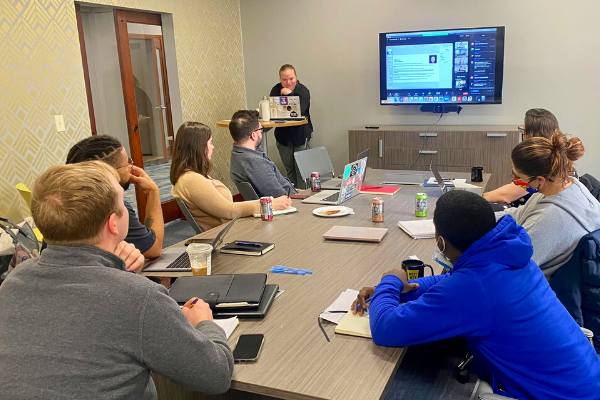
By Amy Erickson
At Innovation Studio, we spend a lot of time talking with new business owners and prospective entrepreneurs who want to turn their ideas into a business. We talk to people with a real passion: the book lover who wants to open a bookstore, the fiber artist who wants to knit sweaters for sale, or the influencer who wants to build marketing campaigns as an independent consultant. Oftentimes, their biggest question is “How do I know if the hobby I love could make me money?”
First off – we all agree that doing the things you love is crucial to your mental health and hobbies can have many mental health benefits. Finding something you love that brings you joy is important. But if you think you’re ready to turn these passions and moments of joy into a business that will support your lifestyle, then you first have to figure out what success looks like for your business and for you.
During Innovation Studio’s CREATE program, we dive into how to build a successful business based on what you love to do. All successful businesses have three attributes in common. They are:
- Profitable
- Sustainable
- Scalable
Is it Profitable?
A business needs to make a profit – it must make more money than it costs – in order to result in a positive income. All business models must make a profit – even non-profits must bring in more money than they spend to do their business. If your business is not making you a profit, it is a hobby.
For example – If you knit socks and you want to sell your socks for your business you need to calculate how much it costs to make a pair of socks (Materials + Labor) as well as the cost to sell the pair of socks (Overhead + any Additional Costs like packaging etc). Your formula would look something like this:
Cost of Pair of Socks = Cost of Materials + Cost of Labor + Cost of Overhead + Additional Costs
So if the yarn cost $5 for a pair of socks, you spent one hours on the pair and want an hourly rate of $10/hour, your overhead calculates to $3, and it costs $1 to package the socks for sale you would calculate your cost as:
$5 + $10 + $3 + $1 = $19
You would need to sell your socks for more than $19 to make a profit or have a profitable business. Let’s assume you decide to sell each pair of socks for $25/pair.
Is Your Business Idea Sustainable?
In order to have a business that is sustainable, it must be able to continue into the future without sacrificing the resources needed for the future. These could be environmental, social, or economic resources that the business needs in order to produce its product or service.
Now – is your knitting business sustainable?
You can ensure your business is environmentally sustainable by first thinking about the materials you plan to use and the end of life cycle for your socks, including how long each pair will last. If you are committed to renewable resources and making a quality product that can be worn many times, you can ensure that your business is environmentally sustainable
Social sustainability involves ensuring that you are protecting the wellbeing of both your customers and employees. Ensuring that your socks are safe – the dyes aren’t going to poison the wearers, your employees are being fairly compensated and aren’t being injured etc. As a small business owner, you may think you only need to worry about your customer, but it is crucial that you don’t overwork yourself and end up burning out. Your business will not be sustainable if you can’t work reasonable hours and make your sales goals.
This ties into being economically sustainable. All businesses, but especially brand new businesses like a sock knitting business, must be aware of their cost management as well as time management. By instituting efficient manufacturing processes to reduce the time spent, control for burnout and watch your costs, you can ensure your business is economically sustainable.
Finally, Is Your Business Model Scalable?
A business needs to grow in order to survive. Business growth helps cover rising costs, withstand economic changes, and seize opportunities to better serve customers.
You need to ask yourself, as my product or service gains popularity, can I scale to meet demand?
If you make one pair of socks a day, you can sell only seven pairs a week. At $25/pair that will only be a profit of $49/week. To increase sales, boost your sock output or find scalable products.
For a knitted sock business, scalability may take on multiple forms. You could knit faster, use a knitting machine, hire knitters, or raise prices to meet demand and increase profit.
You could even scale some other part of your business – maybe sell patterns for people to knit at home – or set up virtual knitting training classes to teach others to knit. These things are scalable as they can be more passive, allowing you to earn money without over committing your time. All of these options have their own advantages and disadvantages, so you will need to do your own research and come up with the best answer for your business.
Ultimately, if you want to turn your hobby or special interest into a business you need to find ways to make what you do solve a problem in the world that people are looking to be solved. Innovation Studio’s CREATE program supports brand new entrepreneurs in turning their ideas into reality through a series of classes designed to help you test whether or not your product or service is profitable, sustainable, or scalable. Remember a hobby is great! But it is not a business.

